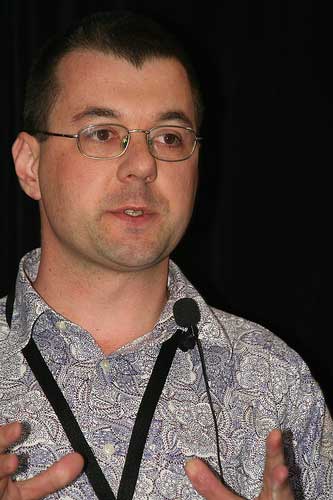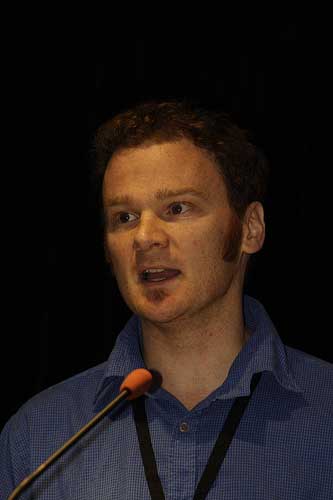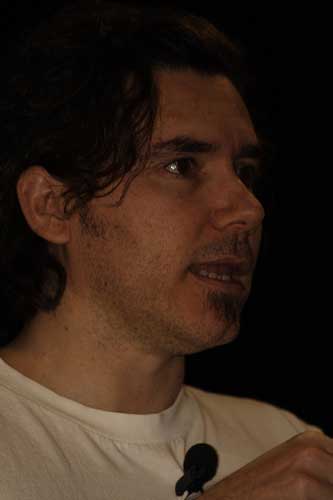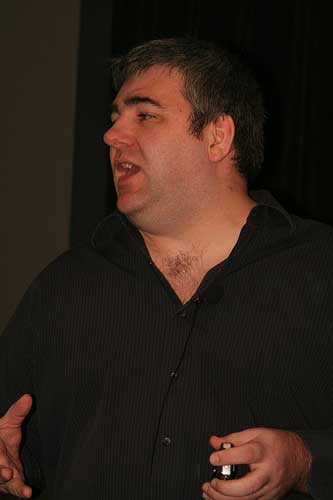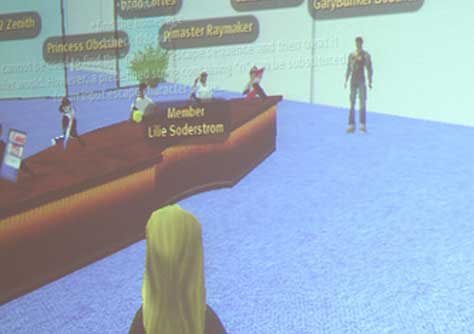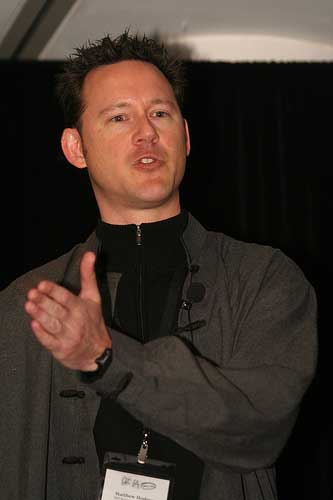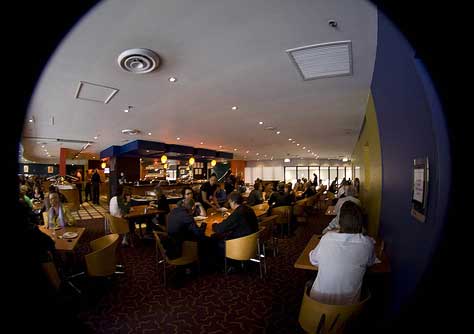As you’d expect, the conference reflected the issues participants face, including what is possibly the biggest issue at the moment: the current shortage of expertise! There just aren’t enough skilled IA practitioners in the Australian market, and each of the organizations taking part in the conference took the opportunity to let the community know they were looking to hire.
Another issue we face is defining what it is we do and how we do it. The topics presenters discussed reflected these issues—from topics relating to the more cerebral level at which IAs operate, to interacting with other disciplines in business, to strategy, and to topics much more at the hands-on level.
Above all, gathering all the great people who make up this community was a great benefit in itself. The level of discussion and debate—both during and between sessions—is a promising sign.
The driving force behind OZ-IA is Eric Scheid, and he deserves credit for the work he has done to set up and organize the event over the last two years. Eric is an experienced IA, well known in Australia through his work at Ironclad Networks, and possibly most importantly, he is passionate about IA. It is this passion that has achieved what nobody else has even attempted.
Organization
The conference had an early start at 8:10 am on a Saturday morning. That’s right, this was a weekend conference, which was more than evident on the faces of some attendees that morning. A bit of a rocky start, no doubt, but before long, we were firing on all cylinders and getting into the spirit.
The conference chair, Tudor Goode, made a good effort to keep things on schedule, which is not always an easy job, considering how much we like to talk! While some speakers went over their time a little, this was usually due to a healthy discussion with the audience. A relevant sponsor introduced each speaker.
Even with strict scheduling, the combination of eight sessions per day, with a coffee break after every single session, made for two long days. This also meant each presenter had only 45 minutes, including question time. Breaks were too short and too frequent, disrupting the flow and pace of the day, and requiring the herding of attendees like cattle to try and keep to the schedule.
Freely available wireless Internet kept people blogging,![]() Flickring,
Flickring,![]() and Twittering
and Twittering![]() over both days. The A/V setup went without a hitch.
over both days. The A/V setup went without a hitch.
Talking to attendees afterward, there was some debate over the virtues of the holding the conference on a weekend. Some suggested that freelancers find it easier to attend on the weekend, because otherwise, they would be missing out on income. But freelancers are more easily able to shift their time and thus could make up the same number of working hours. Others suggested that the weekend schedule mimicked the IA Summit, at which conference sessions occur over a weekend. One thing is certain: holding a conference on a weekend did not seem very popular.
Overall, preparation for the conference seemed to be fairly last minute. While everything worked out okay on the day, the finishing touches of a professional conference were lacking. For example, event promotion, the selection of speakers, and the release of the conference program all occurred very close to the start of the event.
Content & Presenters
This year’s presenters covered a wide range of topics, offering something of interest to everyone. Although there were no official tracks, two major themes emerged in the presentations:
- the big picture
- IA methodology
In keeping with the relaxed style of the event, quite a friendly attitude was apparent among participants. This broke down barriers between attendees and presenters, who chatted during breaks, as shown in Figure 1, and there was good interaction between the different disciplines that made up the audience.
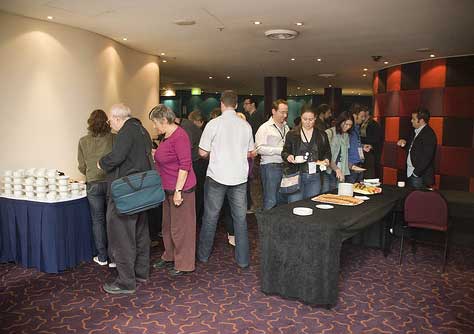
The line-up of presenters represented a good selection of local expertise, plus a number of international speakers. While the aim of an Australian conference should surely be to promote local knowledge, it would have been good to have more international speakers. After all, part of the problem for practitioners working in Australia is the difficulty in getting overseas to see the big names and thought leaders. So we should be bringing them to us rather than us going to see them elsewhere, a strategy that has worked well for other local events such as Web Directions South.
Some things one might expect in a conference did not feature in this year’s OZ-IA, including tracks on different topics, workshops, and keynote speakers. Parallel tracks would allow a greater number of speakers and cater to different audiences’ needs more effectively. Pre-conference workshops are often a valuable component of other conferences, especially for those who are new to the field. Keynote, or plenary, speakers often effectively set the overall direction for a conference—and a community of practice—providing much needed thought leadership. In fact, I often find the keynotes to be the best part of a conference.
In the following sections, I’ve summarized each session, but you can find more information on each presentation—as well as slides, podcasts, and, in some cases, video—on the OZ-IA![]() Web site.
Web site.
The Big Picture Theme
As information architects, we often need to take a step back and see the big picture. This might include viewing our work in a business context—including dealing with clients and contracts and having to sell our expertise. We also sometimes need to compromise—recognizing that there are other factors besides what we think is the right way to do something. Therefore, the conference’s big picture theme is very important—though it does require a departure from our typical discussions about wireframes and Visio tricks.
Designing Sites People Love—Balancing Emotion with Business Reality
Presenters: Elizabeth Pek and Andy Coffey
In “Designing Sites People Love—Balancing Emotion With Business Reality,”![]() Elizabeth Pek and Andy Coffey, who is shown in Figure 2, talked about balancing user and business objectives, something we all need to deal with. They also discussed the new design for the Sydney Morning Herald Web site, including its use of “quiet structure.” Of interest to me was their construction of a persona for one of their competitor’s users, allowing them to focus on enticing such users away from other Web sites.
Elizabeth Pek and Andy Coffey, who is shown in Figure 2, talked about balancing user and business objectives, something we all need to deal with. They also discussed the new design for the Sydney Morning Herald Web site, including its use of “quiet structure.” Of interest to me was their construction of a persona for one of their competitor’s users, allowing them to focus on enticing such users away from other Web sites.
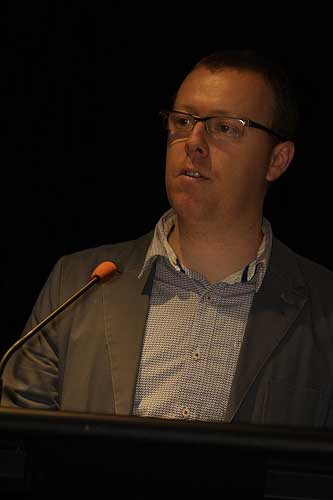
Love in an Elevator—Selling the Value of IA to Business
Presenter: Stephen Collins
In his presentation “Love in an Elevator—Selling the Value of IA to Business,”![]() Stephen Collins talked about the relationship between UX professionals and other disciplines—particularly management and business folks. Again, this is something we all need to deal with, and the consequences of getting this wrong can be difficult to reverse later on.
Stephen Collins talked about the relationship between UX professionals and other disciplines—particularly management and business folks. Again, this is something we all need to deal with, and the consequences of getting this wrong can be difficult to reverse later on.
Rise to Play a Greater Part—Delivering Specs in the Bigger Picture
Presenter: Faruk Avdi
Faruk Avdi continued the big picture theme with his presentation “Rise to Play a Greater Part—Delivering Specs in the Bigger Picture,”![]() discussing how we can improve the planning and scoping of IA work and manage client expectations. There were some interesting discussions around this topic, but there wasn’t sufficient time to explore all of the issues.
discussing how we can improve the planning and scoping of IA work and manage client expectations. There were some interesting discussions around this topic, but there wasn’t sufficient time to explore all of the issues.
ROI in Information Design: Where IA Figures in ID
Presenter: David Sless
David Sless, shown in Figure 3, presented “ROI in Information Design: Where IA Figures in ID,”![]() which focused on the methodology his organization uses. This presentation elicited a strong reaction—though perhaps not immediately apparent. As David is more a member of the Information Design (ID) community than part of the IA community, it was interesting for me to hear his comments regarding diagnostic testing—as opposed to usability testing. Much of the discussion that arose from this presentation centered on the rigor and consistency with which IAs use some techniques—specifically, while some people might not do things in the right way, not all IAs fall into that category.
which focused on the methodology his organization uses. This presentation elicited a strong reaction—though perhaps not immediately apparent. As David is more a member of the Information Design (ID) community than part of the IA community, it was interesting for me to hear his comments regarding diagnostic testing—as opposed to usability testing. Much of the discussion that arose from this presentation centered on the rigor and consistency with which IAs use some techniques—specifically, while some people might not do things in the right way, not all IAs fall into that category.
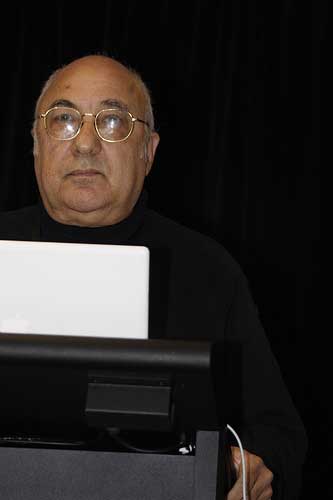
Fast, Cheap, & Somewhat in Control—10 Lessons from the Design of SlideShare
Presenter: Rashmi Sinha
Rashmi Sinha, shown in Figure 4, closed the first day with a presentation on IA and user experience in the context of a startup business, entitled “Fast, Cheap, & Somewhat in Control—10 Lessons from the Design of SlideShare.”![]() Rashmi is an engaging speaker, with a no-nonsense attitude, which was both refreshing and entertaining.
Rashmi is an engaging speaker, with a no-nonsense attitude, which was both refreshing and entertaining.
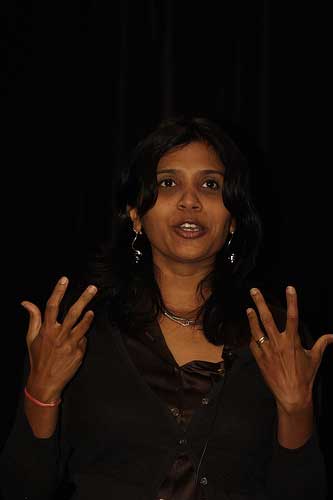
As a core member of the team behind SlideShare, Rashmi revealed the strategy they adopted with regard to usability testing: very little. But this was entirely sensible when you consider they weren’t innovating the user interface to any great extent. Instead, they used conventions other successful Web 2.0 ventures had already established. This brings up an interesting point: How often do we reinvent the wheel simply in the name of best practice? In the agile environment of a startup, is just-in-time design not only helpful, but a necessity?
Ethical Issues and Information Architecture
Presenter: Donna Maurer
On day two, Donna Maurer presented “Ethical Issues and Information Architecture,”![]() discussing what it takes to be an ethical designer. In typical Donna style, she had much to say, and her passion for this topic was obvious. Her presentation quickly got into full swing and raised some interesting questions.
discussing what it takes to be an ethical designer. In typical Donna style, she had much to say, and her passion for this topic was obvious. Her presentation quickly got into full swing and raised some interesting questions.
This is a topic I don’t think people generally give much thought. For instance, do we want to help a client design their Web site if we don’t agree with their stance on environmental protection? Donna suggests we each need to devise our own personal moral guidelines and use them to determine what work we do and who we work with. Generally, as a profession, we need to take a much broader view of what we’re doing and understand the real-world consequences. While this was definitely big picture stuff, Donna also gave some practical tips for practitioners.
Information Architecture of Wikis
Presenter: James Matheson
James Matheson, shown in Figure 5, presented “Information Architecture of Wikis,”![]() more or less giving an introduction to wikis and how information architects can play a role in their development within the enterprise. While there are definitely benefits to using a wiki, this was a topic that could have done with some more time to discuss the practical considerations. Approaching the use of wikis in an enterprise without a clear strategy and an understanding of their suitability can lead to as big a mess as you intended to fix. One good tip James gave us was that it is better to take the role of a gardener, as opposed to trying to strictly control content publishing on an intranet.
more or less giving an introduction to wikis and how information architects can play a role in their development within the enterprise. While there are definitely benefits to using a wiki, this was a topic that could have done with some more time to discuss the practical considerations. Approaching the use of wikis in an enterprise without a clear strategy and an understanding of their suitability can lead to as big a mess as you intended to fix. One good tip James gave us was that it is better to take the role of a gardener, as opposed to trying to strictly control content publishing on an intranet.
